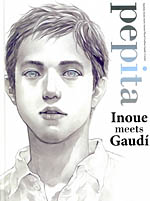 By Takehiko Inoue
By Takehiko Inoue
108 pages, color
Published by Viz
I’ve been a fan of Takehiko Inoue’s for quite a while, especially with his series Slam Dunk, Vagabond, and Real. When I saw that a new art book by Inoue titled Pepita: Inoue meets Gaudi was coming out, I reserved a copy without even thinking twice. I figured based on the cover art that it would be perhaps a travel journal of sorts involving the Catalan architect. What I found was actually a historical telling of Gaudi’s life with some art and photographs mixed in. And while it’s an interesting book, it was definitely not what I was expecting.
Fans of Inoue’s art will probably like the opening section the most, which is exclusively art by Inoue. It’s a mixture of sketches, handmade mosaics, and charcoals. All of the art in these early pages are inspired by Gaudi, either his life or his architecture, and that’s the connection between the two. Because this section comes first, it’s even a reasonable assumption that the entire book will be like this. And while the art here is at times a little rougher than the normally precise, incredibly fine lines that you get from Inoue, you can still see in these sketches his immense talent and great ability to draw such vibrant looking people.
Then you turn the page, though, and suddenly photographs begin to appear alongside essays about Gaudi’s life. It’s a combination of travel journal and biographical stories; Inoue talks about journeying to different, important places in relation to Gaudi. Some have to do with where he lived, others are places that he designed. Occasionally sketches of Inoue accompany these stories, but as the book progresses it’s hard to keep from noticing that the sketches begin to trickle down in frequency. If you’re looking for Inoue’s art above all else, I’ll be honest: Pepita will be a disappointment. And at first, that’s how I felt about the book.
The saving grace of Pepita is that Inoue is a good storyteller, and over time I found myself a bit more interested in the presentations that he put together about Gaudi. I wouldn’t say that by the time Pepita ended that I was Gaudi fan, but I did have somewhat of an appreciation for the architect. At the end of the day, Peptia‘s a strange book, one that straddles numerous lines but I don’t think ever fully embraces one particular genre or storytelling approach. I’ll admit that I wish we’d gotten a lot more art from Inoue here. But while I was a bit disappointed on that front, there’s enough other material here that it’s still interesting. None the less, if you get a chance to look at Pepita before you buy it, I recommend a quick flip-through. It’s a different enough sort of book that it’s definitely not going to be for everyone.
Purchase Links: Amazon.com | Powell’s Books
